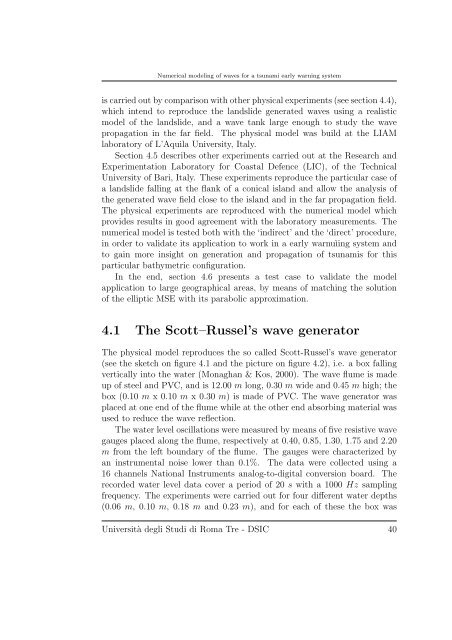Numerical modeling of waves for a tsunami early warning system
Numerical modeling of waves for a tsunami early warning system
Numerical modeling of waves for a tsunami early warning system
Create successful ePaper yourself
Turn your PDF publications into a flip-book with our unique Google optimized e-Paper software.
<strong>Numerical</strong> <strong>modeling</strong> <strong>of</strong> <strong>waves</strong> <strong>for</strong> a <strong>tsunami</strong> <strong>early</strong> <strong>warning</strong> <strong>system</strong><br />
is carried out by comparison with other physical experiments (see section 4.4),<br />
which intend to reproduce the landslide generated <strong>waves</strong> using a realistic<br />
model <strong>of</strong> the landslide, and a wave tank large enough to study the wave<br />
propagation in the far field. The physical model was build at the LIAM<br />
laboratory <strong>of</strong> L’Aquila University, Italy.<br />
Section 4.5 describes other experiments carried out at the Research and<br />
Experimentation Laboratory <strong>for</strong> Coastal Defence (LIC), <strong>of</strong> the Technical<br />
University <strong>of</strong> Bari, Italy. These experiments reproduce the particular case <strong>of</strong><br />
a landslide falling at the flank <strong>of</strong> a conical island and allow the analysis <strong>of</strong><br />
the generated wave field close to the island and in the far propagation field.<br />
The physical experiments are reproduced with the numerical model which<br />
provides results in good agreement with the laboratory measurements. The<br />
numerical model is tested both with the ‘indirect’ and the ‘direct’ procedure,<br />
in order to validate its application to work in a <strong>early</strong> warnuìing <strong>system</strong> and<br />
to gain more insight on generation and propagation <strong>of</strong> <strong>tsunami</strong>s <strong>for</strong> this<br />
particular bathymetric configuration.<br />
In the end, section 4.6 presents a test case to validate the model<br />
application to large geographical areas, by means <strong>of</strong> matching the solution<br />
<strong>of</strong> the elliptic MSE with its parabolic approximation.<br />
4.1 The Scott–Russel’s wave generator<br />
The physical model reproduces the so called Scott-Russel’s wave generator<br />
(see the sketch on figure 4.1 and the picture on figure 4.2), i.e. a box falling<br />
vertically into the water (Monaghan & Kos, 2000). The wave flume is made<br />
up <strong>of</strong> steel and PVC, and is 12.00 m long, 0.30 m wide and 0.45 m high; the<br />
box (0.10 m x0.10 m x0.30 m) is made <strong>of</strong> PVC. The wave generator was<br />
placed at one end <strong>of</strong> the flume while at the other end absorbing material was<br />
used to reduce the wave reflection.<br />
The water level oscillations were measured by means <strong>of</strong> five resistive wave<br />
gauges placed along the flume, respectively at 0.40, 0.85, 1.30, 1.75 and 2.20<br />
m from the left boundary <strong>of</strong> the flume. The gauges were characterized by<br />
an instrumental noise lower than 0.1%. The data were collected using a<br />
16 channels National Instruments analog-to-digital conversion board. The<br />
recorded water level data cover a period <strong>of</strong> 20 s with a 1000 Hz sampling<br />
frequency. The experiments were carried out <strong>for</strong> four different water depths<br />
(0.06 m, 0.10 m, 0.18 m and 0.23 m), and <strong>for</strong> each <strong>of</strong> these the box was<br />
Università degli Studi di Roma Tre - DSIC 40

















